NURS 2006 Assignment 1: Clinical Question on Hand Hygiene and HAI
VerifiedAdded on 2022/11/15
|7
|1270
|438
Essay
AI Summary
This essay addresses the critical issue of hospital-acquired infections (HAIs), also known as nosocomial infections, and their connection to hand hygiene practices within healthcare settings. The author identifies the prevalence of HAIs as a significant clinical problem, particularly in low- and middle-income countries, emphasizing the role of factors such as pathogen presence, infection control practices, and patient immune status. The essay highlights the importance of hand hygiene as a fundamental infection control measure, yet acknowledges low compliance rates among nurses and healthcare staff. To address this, the author formulates a clinical question using the PICOT framework (Population, Intervention, Comparison, Outcome, Time) to investigate the effectiveness of hand hygiene adherence among nurses in preventing HAIs. The essay provides a detailed rationale for the question's selection, discussing its clinical relevance and the need for future research to improve hand hygiene compliance and reduce the burden of HAIs, particularly in nursing practice. The essay concludes by summarizing the key points and suggesting further investigation into the experiences of nurses to understand the causes of non-adherence to hand hygiene protocols.
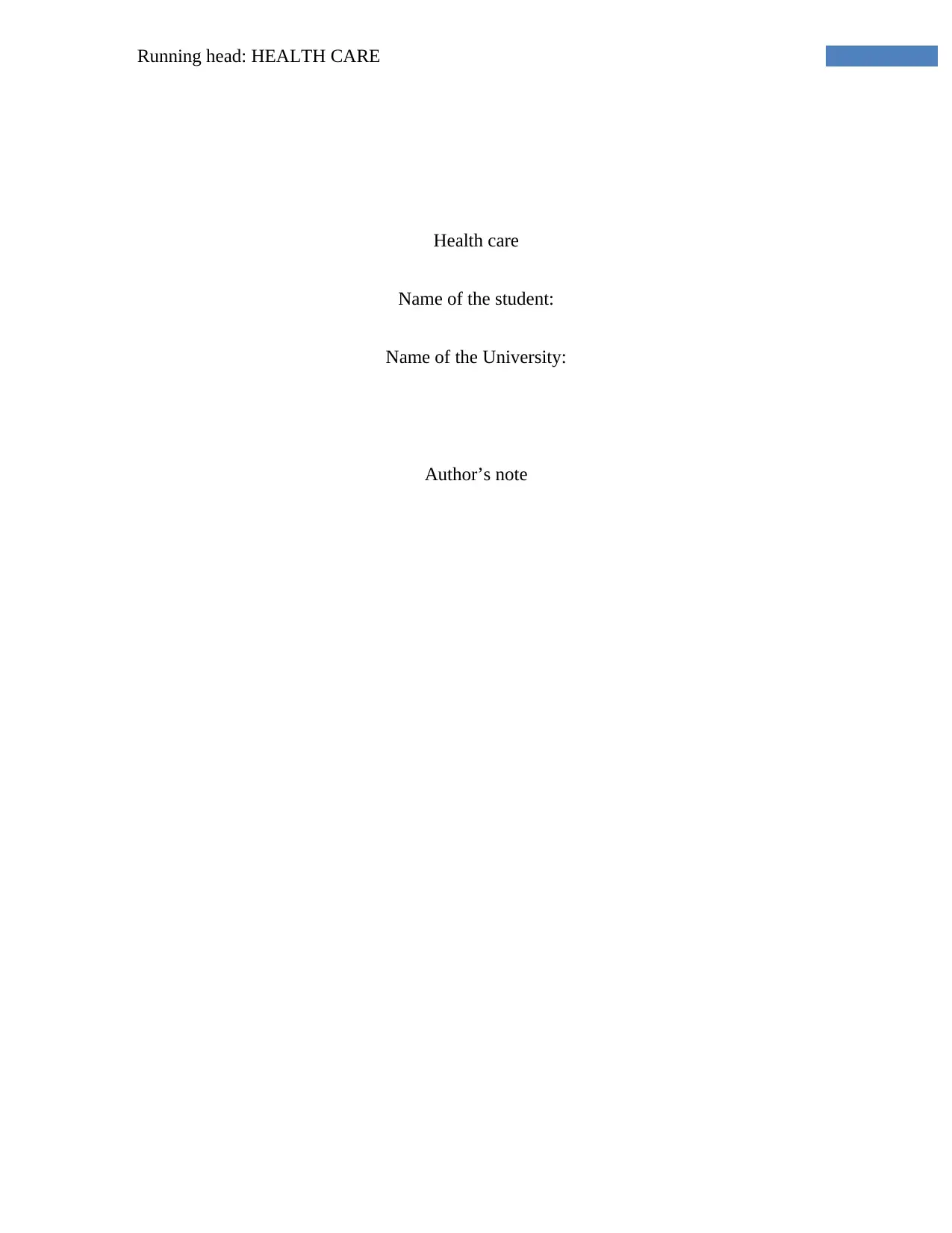
Running head: HEALTH CARE
Health care
Name of the student:
Name of the University:
Author’s note
Health care
Name of the student:
Name of the University:
Author’s note
Paraphrase This Document
Need a fresh take? Get an instant paraphrase of this document with our AI Paraphraser
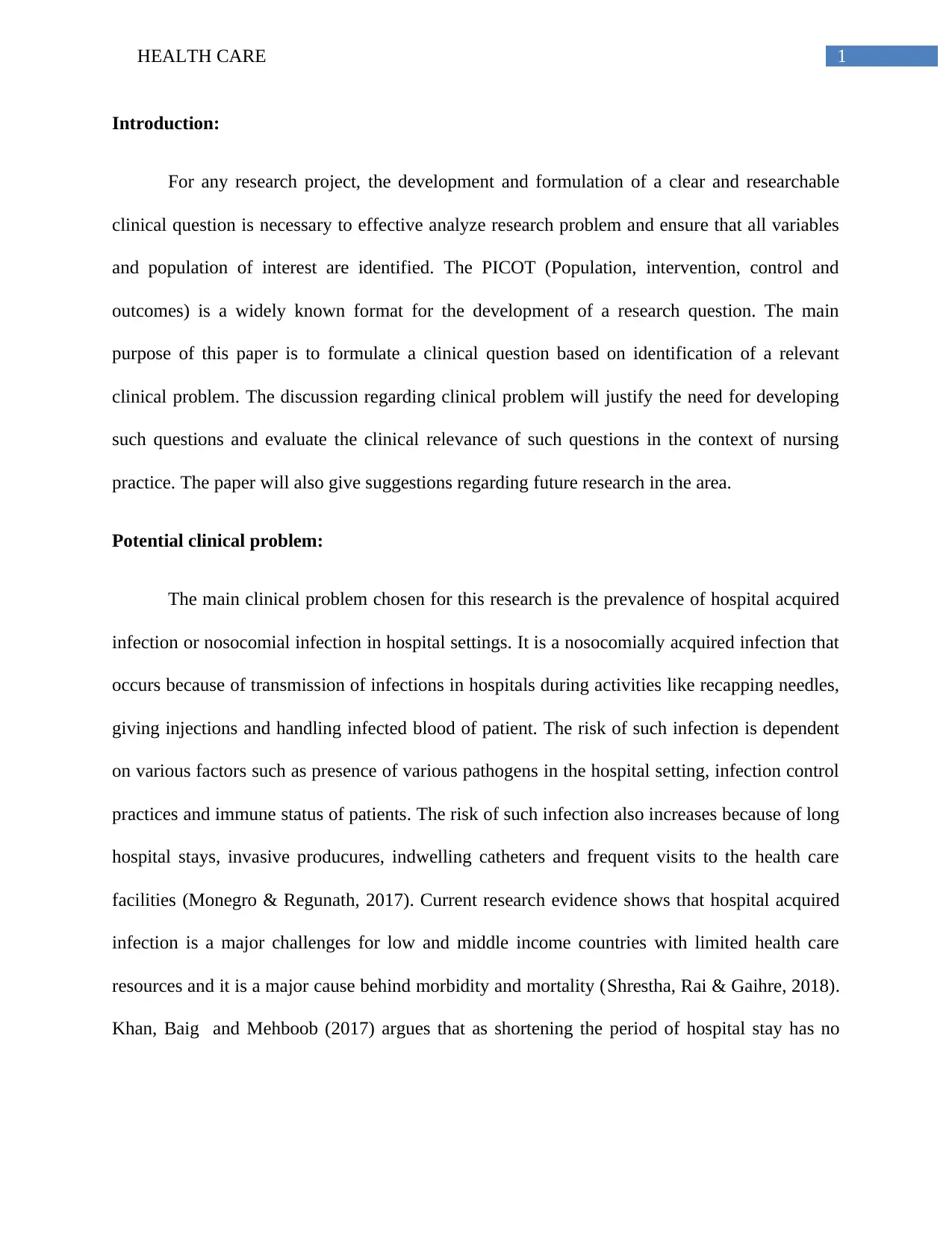
1HEALTH CARE
Introduction:
For any research project, the development and formulation of a clear and researchable
clinical question is necessary to effective analyze research problem and ensure that all variables
and population of interest are identified. The PICOT (Population, intervention, control and
outcomes) is a widely known format for the development of a research question. The main
purpose of this paper is to formulate a clinical question based on identification of a relevant
clinical problem. The discussion regarding clinical problem will justify the need for developing
such questions and evaluate the clinical relevance of such questions in the context of nursing
practice. The paper will also give suggestions regarding future research in the area.
Potential clinical problem:
The main clinical problem chosen for this research is the prevalence of hospital acquired
infection or nosocomial infection in hospital settings. It is a nosocomially acquired infection that
occurs because of transmission of infections in hospitals during activities like recapping needles,
giving injections and handling infected blood of patient. The risk of such infection is dependent
on various factors such as presence of various pathogens in the hospital setting, infection control
practices and immune status of patients. The risk of such infection also increases because of long
hospital stays, invasive producures, indwelling catheters and frequent visits to the health care
facilities (Monegro & Regunath, 2017). Current research evidence shows that hospital acquired
infection is a major challenges for low and middle income countries with limited health care
resources and it is a major cause behind morbidity and mortality (Shrestha, Rai & Gaihre, 2018).
Khan, Baig and Mehboob (2017) argues that as shortening the period of hospital stay has no
Introduction:
For any research project, the development and formulation of a clear and researchable
clinical question is necessary to effective analyze research problem and ensure that all variables
and population of interest are identified. The PICOT (Population, intervention, control and
outcomes) is a widely known format for the development of a research question. The main
purpose of this paper is to formulate a clinical question based on identification of a relevant
clinical problem. The discussion regarding clinical problem will justify the need for developing
such questions and evaluate the clinical relevance of such questions in the context of nursing
practice. The paper will also give suggestions regarding future research in the area.
Potential clinical problem:
The main clinical problem chosen for this research is the prevalence of hospital acquired
infection or nosocomial infection in hospital settings. It is a nosocomially acquired infection that
occurs because of transmission of infections in hospitals during activities like recapping needles,
giving injections and handling infected blood of patient. The risk of such infection is dependent
on various factors such as presence of various pathogens in the hospital setting, infection control
practices and immune status of patients. The risk of such infection also increases because of long
hospital stays, invasive producures, indwelling catheters and frequent visits to the health care
facilities (Monegro & Regunath, 2017). Current research evidence shows that hospital acquired
infection is a major challenges for low and middle income countries with limited health care
resources and it is a major cause behind morbidity and mortality (Shrestha, Rai & Gaihre, 2018).
Khan, Baig and Mehboob (2017) argues that as shortening the period of hospital stay has no
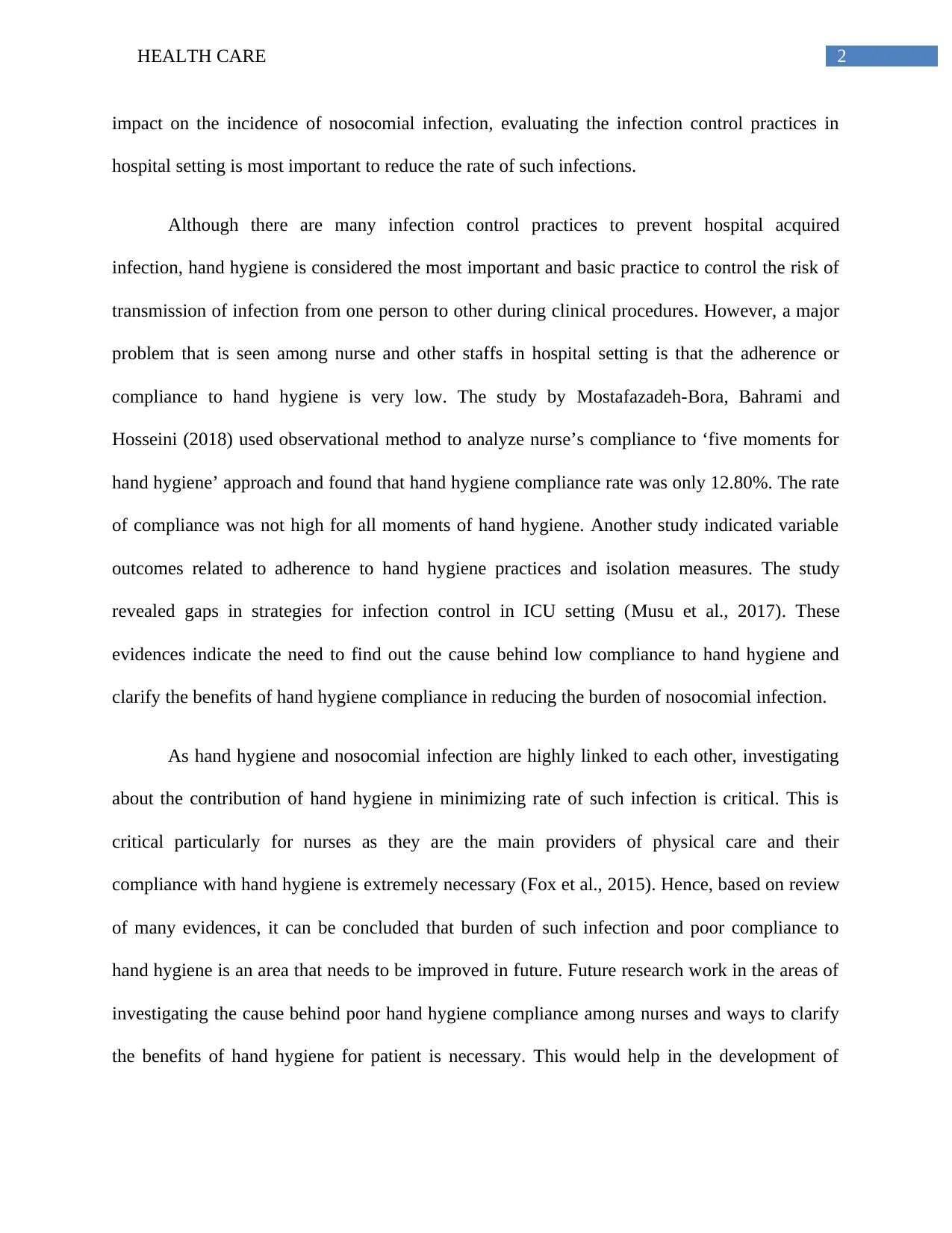
2HEALTH CARE
impact on the incidence of nosocomial infection, evaluating the infection control practices in
hospital setting is most important to reduce the rate of such infections.
Although there are many infection control practices to prevent hospital acquired
infection, hand hygiene is considered the most important and basic practice to control the risk of
transmission of infection from one person to other during clinical procedures. However, a major
problem that is seen among nurse and other staffs in hospital setting is that the adherence or
compliance to hand hygiene is very low. The study by Mostafazadeh-Bora, Bahrami and
Hosseini (2018) used observational method to analyze nurse’s compliance to ‘five moments for
hand hygiene’ approach and found that hand hygiene compliance rate was only 12.80%. The rate
of compliance was not high for all moments of hand hygiene. Another study indicated variable
outcomes related to adherence to hand hygiene practices and isolation measures. The study
revealed gaps in strategies for infection control in ICU setting (Musu et al., 2017). These
evidences indicate the need to find out the cause behind low compliance to hand hygiene and
clarify the benefits of hand hygiene compliance in reducing the burden of nosocomial infection.
As hand hygiene and nosocomial infection are highly linked to each other, investigating
about the contribution of hand hygiene in minimizing rate of such infection is critical. This is
critical particularly for nurses as they are the main providers of physical care and their
compliance with hand hygiene is extremely necessary (Fox et al., 2015). Hence, based on review
of many evidences, it can be concluded that burden of such infection and poor compliance to
hand hygiene is an area that needs to be improved in future. Future research work in the areas of
investigating the cause behind poor hand hygiene compliance among nurses and ways to clarify
the benefits of hand hygiene for patient is necessary. This would help in the development of
impact on the incidence of nosocomial infection, evaluating the infection control practices in
hospital setting is most important to reduce the rate of such infections.
Although there are many infection control practices to prevent hospital acquired
infection, hand hygiene is considered the most important and basic practice to control the risk of
transmission of infection from one person to other during clinical procedures. However, a major
problem that is seen among nurse and other staffs in hospital setting is that the adherence or
compliance to hand hygiene is very low. The study by Mostafazadeh-Bora, Bahrami and
Hosseini (2018) used observational method to analyze nurse’s compliance to ‘five moments for
hand hygiene’ approach and found that hand hygiene compliance rate was only 12.80%. The rate
of compliance was not high for all moments of hand hygiene. Another study indicated variable
outcomes related to adherence to hand hygiene practices and isolation measures. The study
revealed gaps in strategies for infection control in ICU setting (Musu et al., 2017). These
evidences indicate the need to find out the cause behind low compliance to hand hygiene and
clarify the benefits of hand hygiene compliance in reducing the burden of nosocomial infection.
As hand hygiene and nosocomial infection are highly linked to each other, investigating
about the contribution of hand hygiene in minimizing rate of such infection is critical. This is
critical particularly for nurses as they are the main providers of physical care and their
compliance with hand hygiene is extremely necessary (Fox et al., 2015). Hence, based on review
of many evidences, it can be concluded that burden of such infection and poor compliance to
hand hygiene is an area that needs to be improved in future. Future research work in the areas of
investigating the cause behind poor hand hygiene compliance among nurses and ways to clarify
the benefits of hand hygiene for patient is necessary. This would help in the development of
⊘ This is a preview!⊘
Do you want full access?
Subscribe today to unlock all pages.

Trusted by 1+ million students worldwide
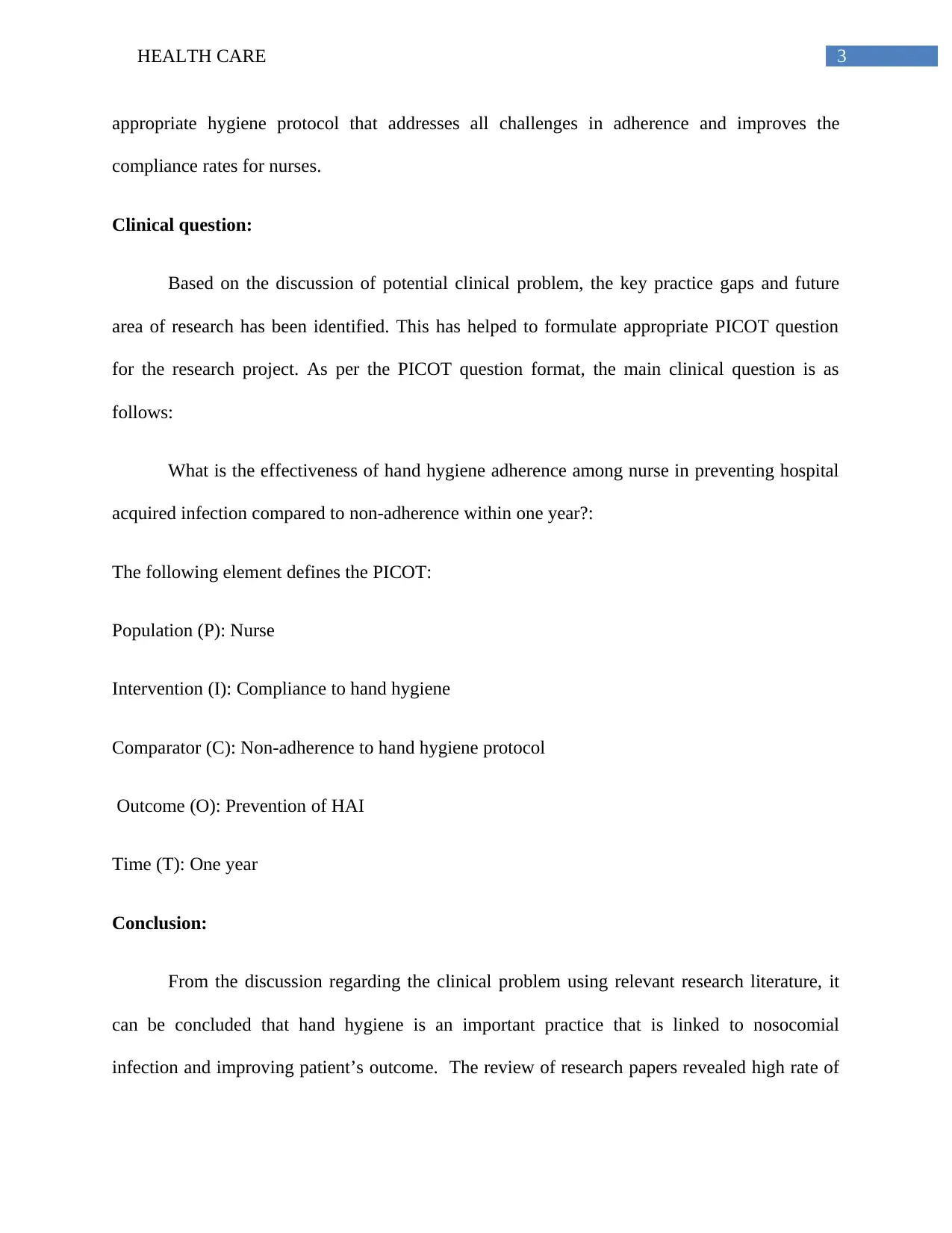
3HEALTH CARE
appropriate hygiene protocol that addresses all challenges in adherence and improves the
compliance rates for nurses.
Clinical question:
Based on the discussion of potential clinical problem, the key practice gaps and future
area of research has been identified. This has helped to formulate appropriate PICOT question
for the research project. As per the PICOT question format, the main clinical question is as
follows:
What is the effectiveness of hand hygiene adherence among nurse in preventing hospital
acquired infection compared to non-adherence within one year?:
The following element defines the PICOT:
Population (P): Nurse
Intervention (I): Compliance to hand hygiene
Comparator (C): Non-adherence to hand hygiene protocol
Outcome (O): Prevention of HAI
Time (T): One year
Conclusion:
From the discussion regarding the clinical problem using relevant research literature, it
can be concluded that hand hygiene is an important practice that is linked to nosocomial
infection and improving patient’s outcome. The review of research papers revealed high rate of
appropriate hygiene protocol that addresses all challenges in adherence and improves the
compliance rates for nurses.
Clinical question:
Based on the discussion of potential clinical problem, the key practice gaps and future
area of research has been identified. This has helped to formulate appropriate PICOT question
for the research project. As per the PICOT question format, the main clinical question is as
follows:
What is the effectiveness of hand hygiene adherence among nurse in preventing hospital
acquired infection compared to non-adherence within one year?:
The following element defines the PICOT:
Population (P): Nurse
Intervention (I): Compliance to hand hygiene
Comparator (C): Non-adherence to hand hygiene protocol
Outcome (O): Prevention of HAI
Time (T): One year
Conclusion:
From the discussion regarding the clinical problem using relevant research literature, it
can be concluded that hand hygiene is an important practice that is linked to nosocomial
infection and improving patient’s outcome. The review of research papers revealed high rate of
Paraphrase This Document
Need a fresh take? Get an instant paraphrase of this document with our AI Paraphraser
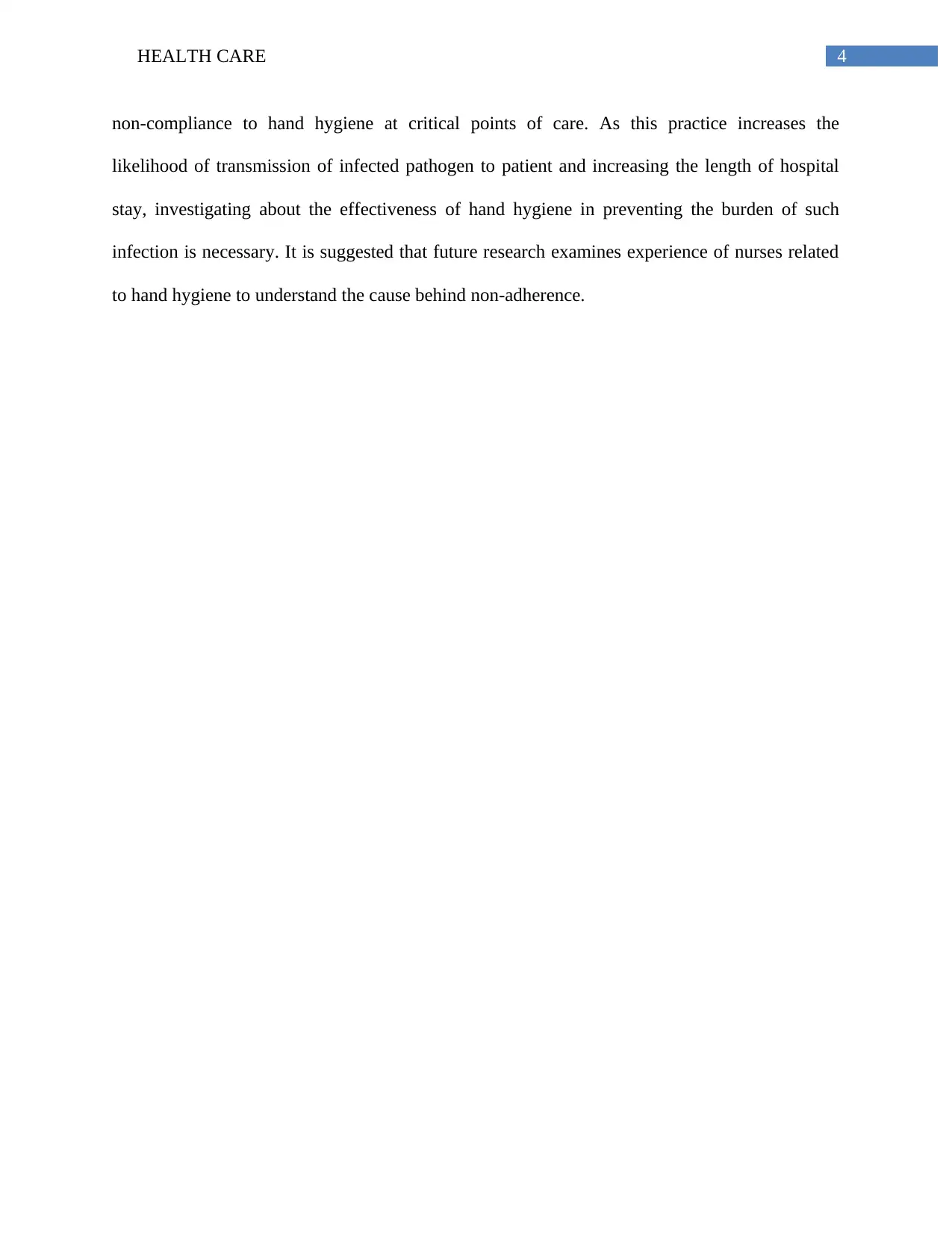
4HEALTH CARE
non-compliance to hand hygiene at critical points of care. As this practice increases the
likelihood of transmission of infected pathogen to patient and increasing the length of hospital
stay, investigating about the effectiveness of hand hygiene in preventing the burden of such
infection is necessary. It is suggested that future research examines experience of nurses related
to hand hygiene to understand the cause behind non-adherence.
non-compliance to hand hygiene at critical points of care. As this practice increases the
likelihood of transmission of infected pathogen to patient and increasing the length of hospital
stay, investigating about the effectiveness of hand hygiene in preventing the burden of such
infection is necessary. It is suggested that future research examines experience of nurses related
to hand hygiene to understand the cause behind non-adherence.
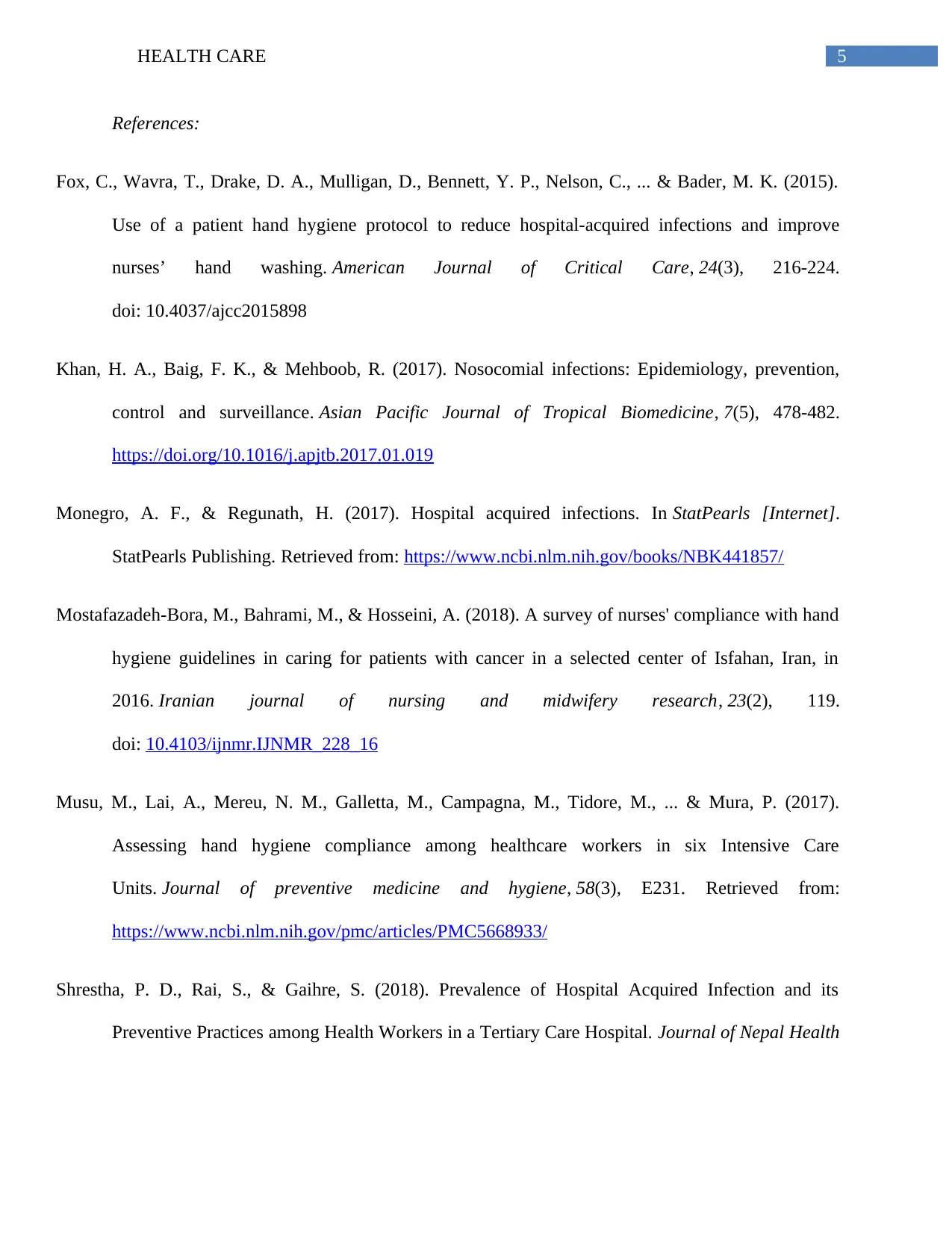
5HEALTH CARE
References:
Fox, C., Wavra, T., Drake, D. A., Mulligan, D., Bennett, Y. P., Nelson, C., ... & Bader, M. K. (2015).
Use of a patient hand hygiene protocol to reduce hospital-acquired infections and improve
nurses’ hand washing. American Journal of Critical Care, 24(3), 216-224.
doi: 10.4037/ajcc2015898
Khan, H. A., Baig, F. K., & Mehboob, R. (2017). Nosocomial infections: Epidemiology, prevention,
control and surveillance. Asian Pacific Journal of Tropical Biomedicine, 7(5), 478-482.
https://doi.org/10.1016/j.apjtb.2017.01.019
Monegro, A. F., & Regunath, H. (2017). Hospital acquired infections. In StatPearls [Internet].
StatPearls Publishing. Retrieved from: https://www.ncbi.nlm.nih.gov/books/NBK441857/
Mostafazadeh-Bora, M., Bahrami, M., & Hosseini, A. (2018). A survey of nurses' compliance with hand
hygiene guidelines in caring for patients with cancer in a selected center of Isfahan, Iran, in
2016. Iranian journal of nursing and midwifery research, 23(2), 119.
doi: 10.4103/ijnmr.IJNMR_228_16
Musu, M., Lai, A., Mereu, N. M., Galletta, M., Campagna, M., Tidore, M., ... & Mura, P. (2017).
Assessing hand hygiene compliance among healthcare workers in six Intensive Care
Units. Journal of preventive medicine and hygiene, 58(3), E231. Retrieved from:
https://www.ncbi.nlm.nih.gov/pmc/articles/PMC5668933/
Shrestha, P. D., Rai, S., & Gaihre, S. (2018). Prevalence of Hospital Acquired Infection and its
Preventive Practices among Health Workers in a Tertiary Care Hospital. Journal of Nepal Health
References:
Fox, C., Wavra, T., Drake, D. A., Mulligan, D., Bennett, Y. P., Nelson, C., ... & Bader, M. K. (2015).
Use of a patient hand hygiene protocol to reduce hospital-acquired infections and improve
nurses’ hand washing. American Journal of Critical Care, 24(3), 216-224.
doi: 10.4037/ajcc2015898
Khan, H. A., Baig, F. K., & Mehboob, R. (2017). Nosocomial infections: Epidemiology, prevention,
control and surveillance. Asian Pacific Journal of Tropical Biomedicine, 7(5), 478-482.
https://doi.org/10.1016/j.apjtb.2017.01.019
Monegro, A. F., & Regunath, H. (2017). Hospital acquired infections. In StatPearls [Internet].
StatPearls Publishing. Retrieved from: https://www.ncbi.nlm.nih.gov/books/NBK441857/
Mostafazadeh-Bora, M., Bahrami, M., & Hosseini, A. (2018). A survey of nurses' compliance with hand
hygiene guidelines in caring for patients with cancer in a selected center of Isfahan, Iran, in
2016. Iranian journal of nursing and midwifery research, 23(2), 119.
doi: 10.4103/ijnmr.IJNMR_228_16
Musu, M., Lai, A., Mereu, N. M., Galletta, M., Campagna, M., Tidore, M., ... & Mura, P. (2017).
Assessing hand hygiene compliance among healthcare workers in six Intensive Care
Units. Journal of preventive medicine and hygiene, 58(3), E231. Retrieved from:
https://www.ncbi.nlm.nih.gov/pmc/articles/PMC5668933/
Shrestha, P. D., Rai, S., & Gaihre, S. (2018). Prevalence of Hospital Acquired Infection and its
Preventive Practices among Health Workers in a Tertiary Care Hospital. Journal of Nepal Health
⊘ This is a preview!⊘
Do you want full access?
Subscribe today to unlock all pages.

Trusted by 1+ million students worldwide
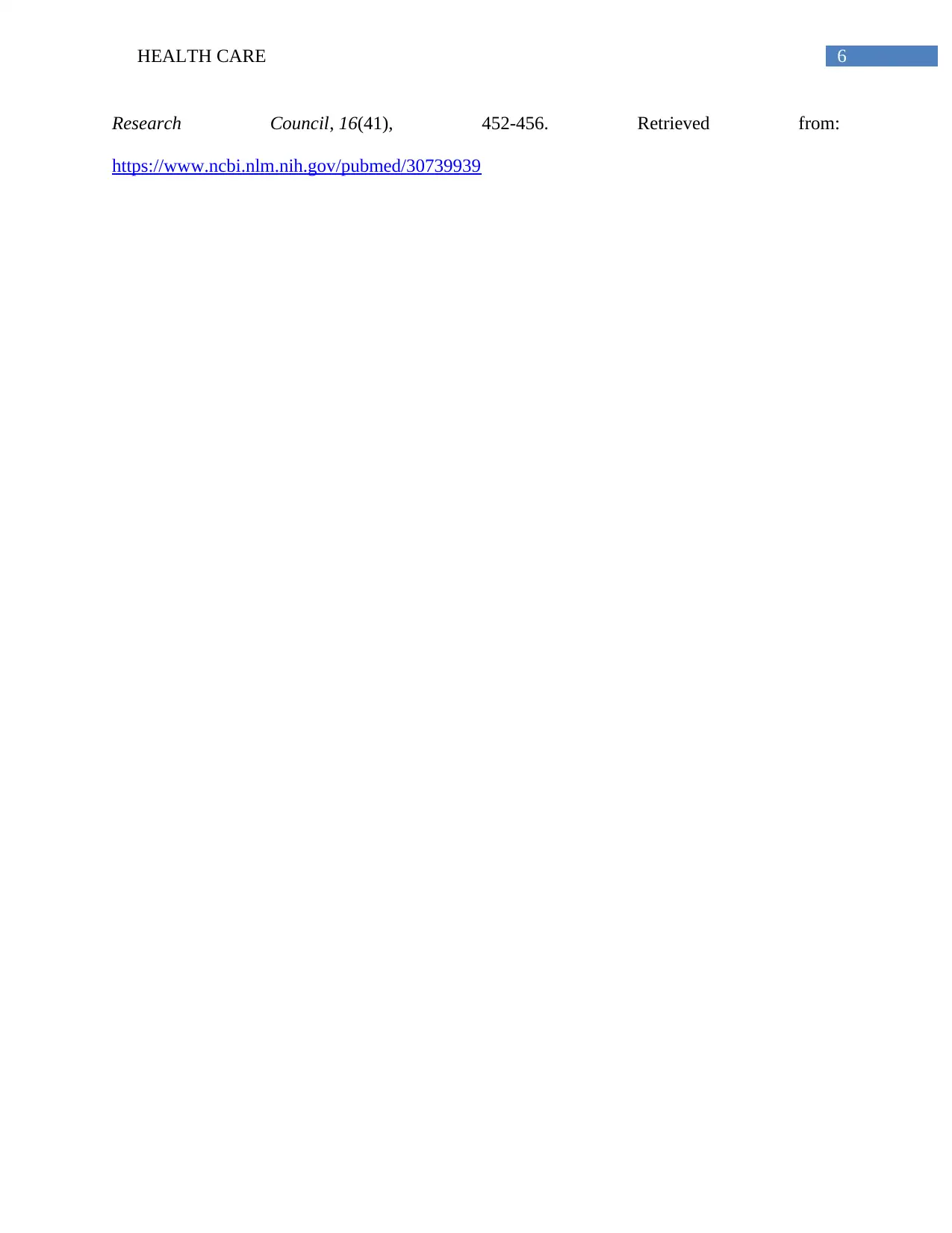
6HEALTH CARE
Research Council, 16(41), 452-456. Retrieved from:
https://www.ncbi.nlm.nih.gov/pubmed/30739939
Research Council, 16(41), 452-456. Retrieved from:
https://www.ncbi.nlm.nih.gov/pubmed/30739939
1 out of 7
Related Documents
Your All-in-One AI-Powered Toolkit for Academic Success.
+13062052269
info@desklib.com
Available 24*7 on WhatsApp / Email
![[object Object]](/_next/static/media/star-bottom.7253800d.svg)
Unlock your academic potential
Copyright © 2020–2025 A2Z Services. All Rights Reserved. Developed and managed by ZUCOL.





